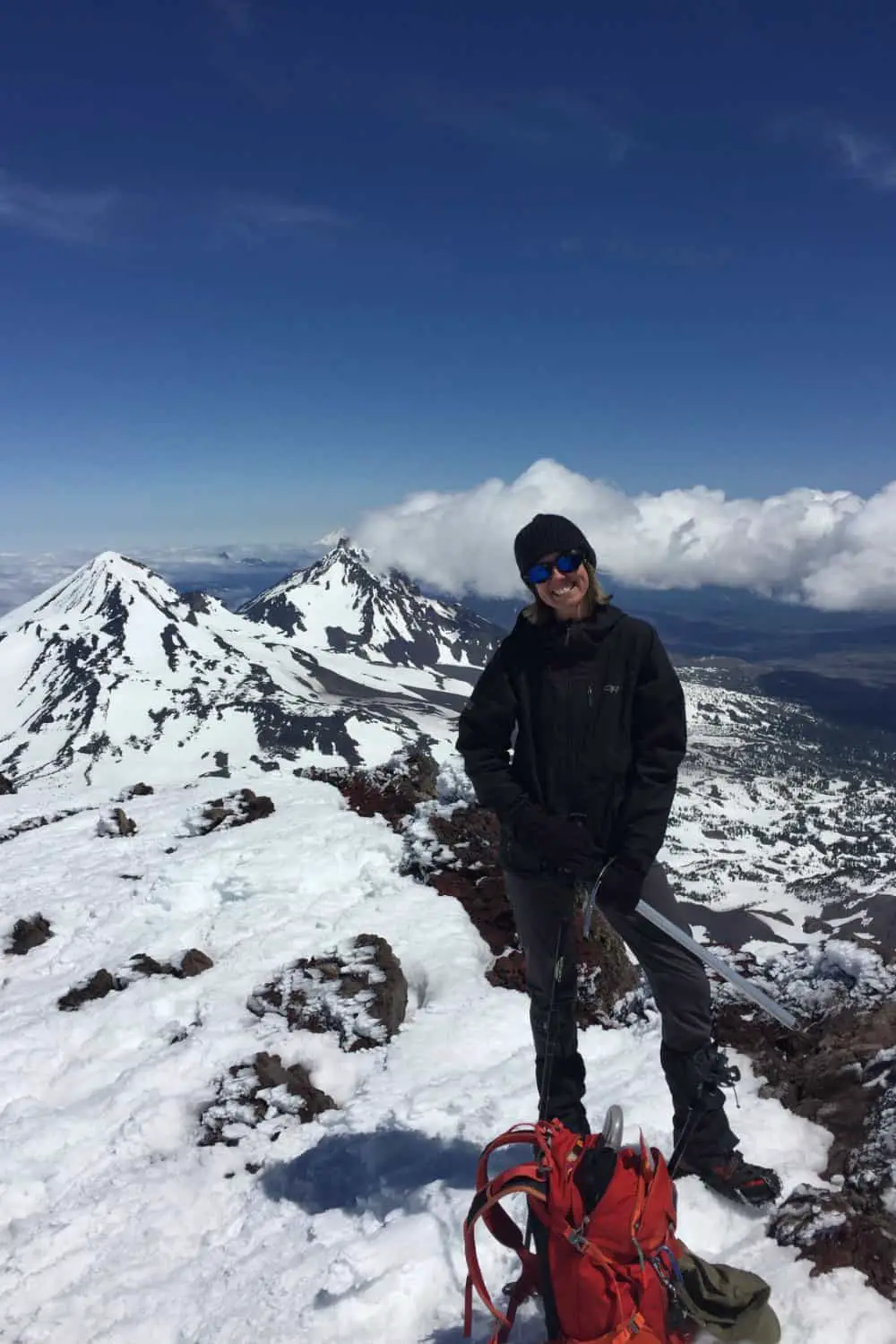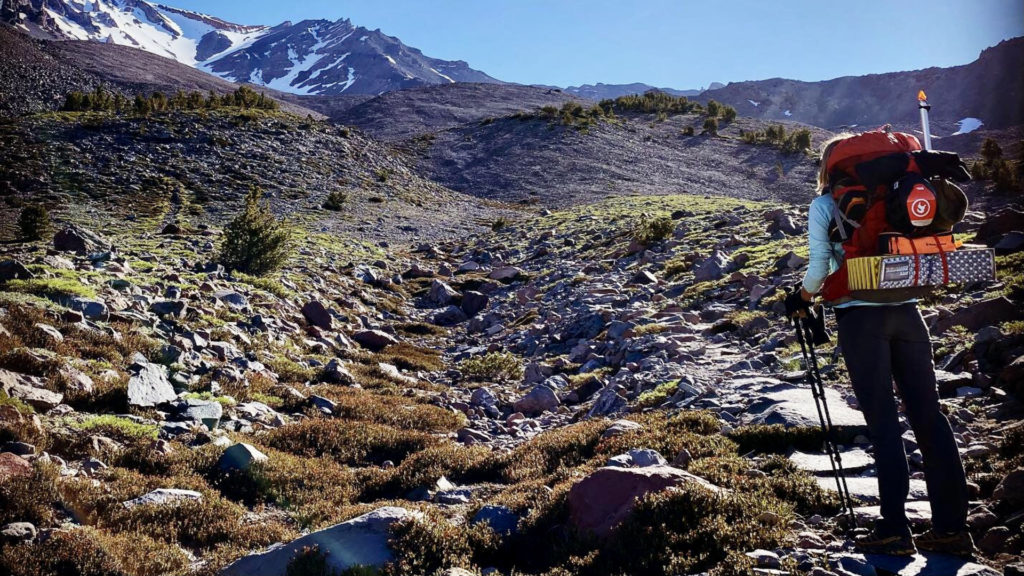Take the day pack and beef it up a bit with more padding, more support, thicker fabrics, and often a separate compartment for your sleeping bag in the bottom of the pack, and there you have the Overnight Pack, sometimes referred to as a weekend pack. Most of the packs of this size have plenty of external shove-it pockets, smaller zippered hip pockets, a hydration reservoir, either a fixed or detachable top lid section, and loops for poles and axes, in a 30-50L capacity. This size pack is great for weekend getaways but consider also for day hikes with kids, so you can carry some of their gear and lighten their load, giving them the most enjoyable outdoor experience possible.
An overnight pack is big enough to carry a lightweight sleeping bag, small tent, sleeping pad, extra layers, gloves, hat, sunscreen, eye protection, and headlamp. Other things you’ll need to carry are food, a small stove and fuel, cookware, a water filter/purifier, first aid kit, navigation, and the rest of the ten essentials.
Types of Frames
Internal frame: Overnight packs will have a durable internal frame to help support and evenly distribute the weight of your load. Some packs include plastic framesheets that give the pack some structure; others get sturdier bones from aluminum rods.
Frameless: Figure the more substantial the frame, the more weight the pack can typically handle. Frameless packs are lightweight and compact, making them great for lighter loads but not for the pounds an overnight requires.
Pack Access
Top: The majority of overnight packs are a top-loading design, allowing you to stuff the bottom of your pack with your sleeping bag, stove, and other items not needed until later. Some top-loaders offer a “floating” (extendable) top lid that allows you to overstuff the pack a bit.
Front or bottom: Packs with front panel access offer access to the main storage compartment via a U-shaped zipper which enables you to get to those bottom of the pack items without having to pull everything on top out. Some packs offer a bottom zipper to accomplish the same thing. This is ideal for being able to set up camp without strewing your stuff all over to get to your overnight items.
Side: A side zip to the main storage compartment is an option on some overnight packs. This is typically in addition to top or front access and is just one more way to access deep-pack items without unpacking.
Hydration Reservoir
Most overnight packs have an inside pocket that you can slip a hydration reservoir into. Depending on the make and model you decide on, the reservoirs (also called a bladder) will either come with the pack or you’ll need to buy one separately, Average size of reservoirs on this size pack are usually 2-3 liters, which you can refill with water that you have either boiled with something like a JetBoil or filtered with something like a Katadyn BeFree or Sawyer Squeeze.
Additional Features
Suspended mesh back panel: Most larger packs these days have a ventilated back panel made of mesh that’s constructed so the pack sits a few inches away from your body, cutting down on back sweat and giving your spine a break.
Raincover: If there is even a chance of rain on your trip, consider a raincover, or its cheap alternative, the Hefty bag. A lot of folks line their packs with one but you could also pull one over your pack, cutting holes for the straps. It may not be the most elegant look but it will be rainproof.
Sleeping bag compartment: Packs of this size usually have zippered access to a sleeping bag compartment at the bottom of the pack.
Fitting your pack
It’s recommended to try on a bunch of packs in person to ensure the right fit. You’ll want to look for the following:
- Torso length: The length of your torso, not your height, is important here. Most packs are available in multiple sizes, from extra small to large, and can be fine-tuned with strap adjustments. Position the hipbelt so the top edge is about one finger width above the top of your hips, then look at how the shoulder straps land on your back and shoulders. If there is a gap at the top of your shoulders, the pack is likely too long for your torso. If the straps are a ways down your back before they connect to the pack, the pack might be too short.
- Hip size: Hipbelts usually accommodate a wide range of hip sizes, from the mid-20 inches to the mid-40 inches so often it’s not the size that’s the issue here but the feel of the belt itself, the angle of the pockets and padding and how they feel on you hipbones. Osprey and REI have this great oven set-up where you can have your hip belt heat-molded to your body. As someone with prominent hipbones, this was a nice touch and swayed me to buy Osprey.
- Women-specific backpacks: Torso dimensions are shorter on these packs than on men’s or unisex packs, and hipbelts and shoulder straps are contoured with our body shape in mind, and sternum straps are usually a smidge higher.
- Load Lifter Straps: Some overnight and multiday packs have additional straps stitched into the top of the shoulder straps which connect to the top of the pack frame, creating a 45° angle between your shoulder straps and the pack, preventing the upper portion of the pack from pulling away from your body, which would cause the pack to rest needlessly on your lower back.
- Sternum Strap: This mid-chest strap packs allows you to narrow or widen where your shoulder straps sit, which improves comfort, and lock them in place, which improves stability. You’ll enjoy the addition of a sternum strap when traveling on uneven terrain where a pack that’s shifting back and forth can abrade the skin or throw you off balance.
Popular Overnight Packs For Women
(the numbers refer to capacity in liters)
- Osprey Ariel AG 55
- Osprey Aura AG 50
- Osprey Kyte 46
- Deuter ACT Lite 35+10
- REI Women’s FLash 45
- Gregory Octal 45
- Gregory Maven 55
- Arcteryx Bora AR 49
- Kelty Redwing 50
- Mammut Trea Spine 50

Wendy Harrington is a California native who has lived in a small town at the foothills of the Cascade Mountains in Washington state since 2001. Her love of trail running and peakbagging has led her to summit all five Washington volcanoes, climb to the high points of three states, and put nearly a thousand miles a year on her boots. Her loves include ridgelines, saddles, granite, one-day pushes on big mountains, anything volcanic, long solo days, and objectives that push limits and test endurance.

